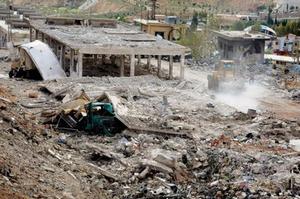SyriaIsrael attacks targets in Syria to prevent advanced arms shipments to Hezbollah
Israeli jets bombed two military targets in Syria – one near the Damascus International Airport, the other near the town of Dima, north of Damascus and near the Syria-Lebanon border – and as has been the case in previous such attacks, there was no confirmation or elaboration from Jerusalem. Syrian general command sources said that several facilities had been hit, both at the Damascus International Airport and in the area of Dimas. This is the tenth Israeli attack against military depots in Syria since January 2013. The attacks have had a specific goal: to prevent the Assad regime and Iran from transferring advanced weapon systems to Hezbollah. When Israel’s intelligence services notice that such systems are gathered for the purpose of shipping them to Hezbollah, the shipments are destroyed before they are delivered to Hezbollah.

Some of the damage from Israel attack on Hezbollah-bound weapons // Source: jbolushi.com
Israeli jets bombed two military targets in Syria – one near the Damascus International Airport, the other near the town of Dima, north of Damascus and near the Syria-Lebanon border – and as has been the case in previous such attacks, there was no confirmation or elaboration from Jerusalem.
The BBC quotes the Syrian general command to say that several facilities had been hit, both at the Damascus International Airport and in the area of Dimas.
Syrian media reported the Israeli air force flew at least ten sorties over the Dimas area and attacked several military targets.
Salim Idris, a former commander of the Free Syrian Army, and Western intelligence services, said the targets of the attacks were likely advanced arms shipments from Iran and the Assad regime to Hezbollah.
“This aggression proves Israel’s direct involvement in supporting terror in Syria, along with other Arab and regional countries,” the Syrian military command said.
“The Israeli attack was designed to lift the morale of the terror groups, primarily Jabhat al-Nusra and the Islamic State, after the blows they have received from the Syrian army.”
The BBC quotes Lebanese sources reporting that Israeli planes had been flying over southern Lebanon since Sunday morning, probably in preparation for the afternoon attack.
Haaretz reports that Prime Minister Benjamin Netanyahu cancelled a planned live video broadcast on Sunday evening due to “events in Jerusalem.”
Earlier, during the weekly cabinet meeting, Netanyahu said that Israel “is following the Middle East and what is happening very closely, with wide open eyes and ears — and a lot is happening.
“We will continue to keep our fingers on the pulse and we will deal with these threats and these challenges, which never take time off. We will deal with them with the same responsibility that we have demonstrated until now.”
This is the tenth Israeli attack against military depots in Syria since January 2013. The attacks have had a specific goal: to prevent the Assad regime and Iran fromtransferring advanced weapon systems to Hezbollah. When Israel’s intelligence services notice that such systems are gathered for the purpose of shipping them to Hezbollah, the shipments are destroyed before they are delivered to Hezbollah. The Israeli airstrikes targeted four categories of armaments:
- Advanced air defense systems such as the SA-17 batteries bombed in a convoy outside Damascus on 30 January 2013. If deployed in Lebanon, theses missile could erode Israel’s air superiority over Lebanon, where the Israel Air Force (IAF) now operate with impunity.
- More accurate surface-to-surface missiles, including the Iranian-made Fateh-110s, targeted in strikes last 2 and 5 May around Damascus. The missiles, with a range of 190 miles and accurate to within 200 yards, missiles could threaten targets such as power plants deep inside Israel.
- Long-range precision land-to-sea missiles such as the Russian-made Yakhont hypersonic anti-ship missiles targeted by Israel at least three times last year, in 5 May, 5 July, and 18 and 20 October. The cruise missiles, flying several times faster than sound, would threaten Israeli ships and off-shore natural gas platforms.
- Chemical weapons, which Syria has agreed to surrender to the UN for destruction. The 30 January 2013 strike on the SA-17 convoy also targeted a biological weapons research facility.
Sunday’s attack was the first since the last Israeli strike, in February (“Hezbollah acknowledges Israel’s Monday air strike, HSNW, 26 February 2014). Unlike all previous strikes, Sunday’s attack was conducted during the day (the February strike, for the first time, included Hezbollah targets inside Lebanon).
